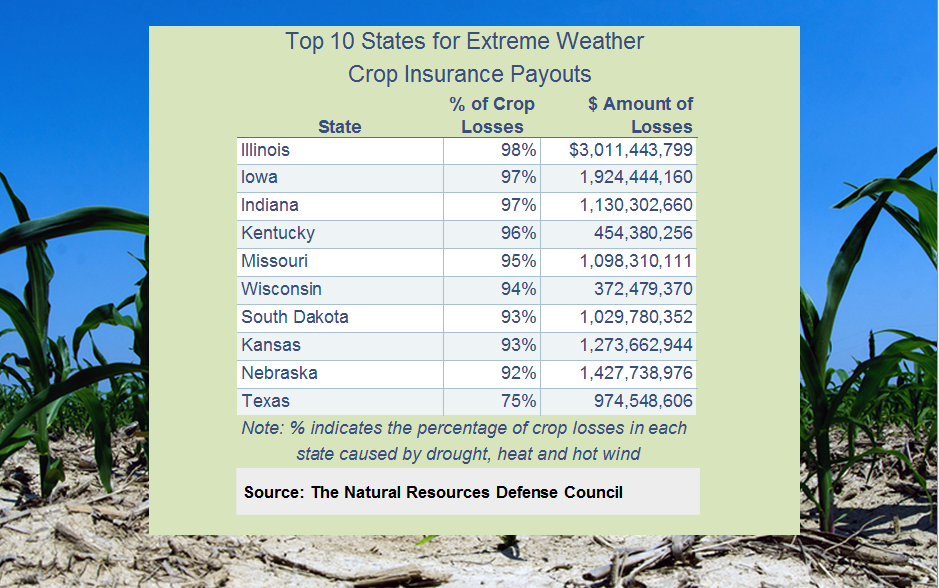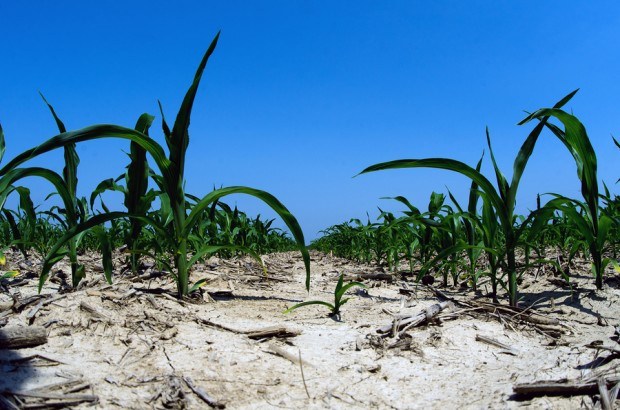The Federal Crop Insurance Program paid out a record-breaking $17.3 billion in crop losses last year, according to a report by the Natural Resources Defense Council (NRDC).
Damage caused by drought, heat and hot wind accounted for 80 percent of all farm losses in 2012, with many upper Midwest and Great Plains states hit hardest.
Crop losses averaged just $4.1 billion a year from 2001-2010, making 2012’s record-breaking payouts even more staggering.
With extreme weather conditions such as drought expected to become more common, insurance payouts will likely continue to increase. However, the NRDC says that widespread adoption of crop-loss prevention methods that build soil health and improve water management on farms can limit these losses.
“The Federal Crop Insurance Program has failed farmers and taxpayers by ignoring water challenges,” says Claire O’Connor, an agricultural water policy analyst at NRDC. “The program was designed to be a safety net—not a subsidy for increasingly risky practices and less sustainable food production. We need to empower farmers to invest in low-risk, water-smart practices that are proven to reduce crop losses.”
NRDC’s study, Soil Matters: How the Federal Crop Insurance Program should be reformed, includes an interactive crop-loss and weather map detailing crop losses county-by-county in all 50 states in 2012, when more than 80 percent of agricultural lands nationwide suffered drought.
The report outlines a crop insurance reform pilot plan that would offer reduced premium rates to farmers who adopt proven soil-building management practices that sustain productive crop yields and result in greater water infiltration, less farm runoff and reduced flooding.
Some of these management practices include:
- Cover crops: Crops are grown with the specific purpose of building soil health and increasing biodiversity on farms focused on growing major commodity crops.
- No-till farming: Farmers plant directly into the stubble from the previous year’s crops, rather than plowing up this residue. The protective stubble serves as mulch that retains soil moisture, suppresses weeds and increases a field’s capacity to grow high-yield crops.
- Improved irrigation scheduling: Farmers apply adaptive irrigating schedules based on frequent examinations of soil health.
“Farmers can apply their own skills to build healthy soil, reduce the worst effects of climate change, and rein in the skyrocketing costs of this program,” says Gabe Brown, Great Plains farmer and soil champion. “Healthy soil is one of the most effective and time-tested insurance policies we have.”





















 Five AI Trends Reshaping Insurance in 2026
Five AI Trends Reshaping Insurance in 2026  10 Highest Class-Action Settlements in 2025 Eclipsed $70B Total: Duane Morris
10 Highest Class-Action Settlements in 2025 Eclipsed $70B Total: Duane Morris  Expense Ratio Analysis: AI, Remote Work Drive Better P/C Insurer Results
Expense Ratio Analysis: AI, Remote Work Drive Better P/C Insurer Results  First Atlantic Hurricane Forecast for 2026 Suggests Season Close to 30-Year Norm
First Atlantic Hurricane Forecast for 2026 Suggests Season Close to 30-Year Norm 